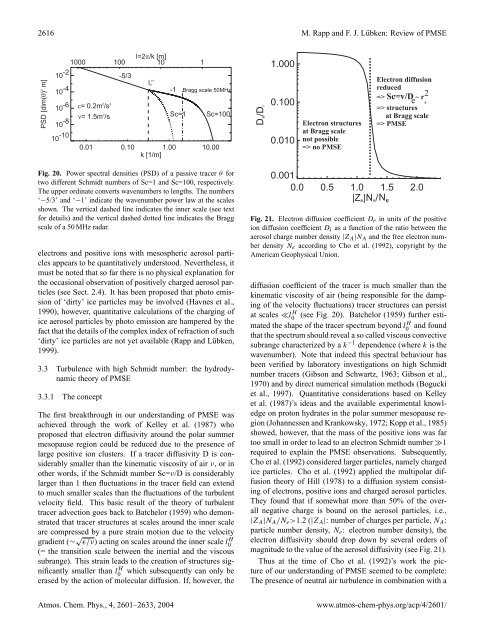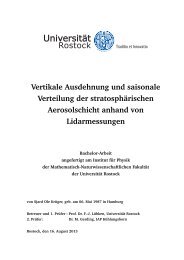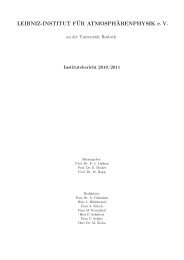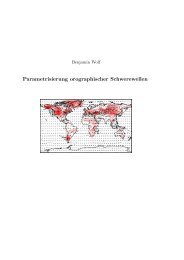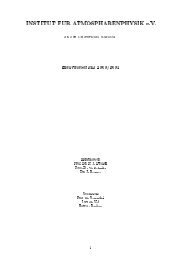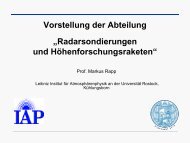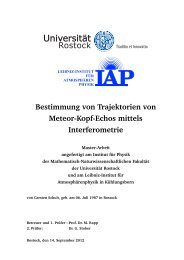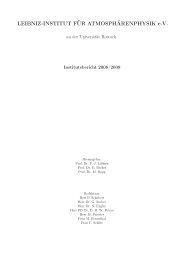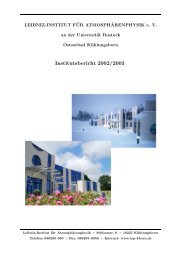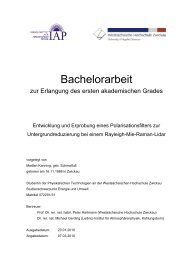Polar mesosphere summer echoes (PMSE): review of ... - HAL
Polar mesosphere summer echoes (PMSE): review of ... - HAL
Polar mesosphere summer echoes (PMSE): review of ... - HAL
Create successful ePaper yourself
Turn your PDF publications into a flip-book with our unique Google optimized e-Paper software.
2616 M. Rapp and F. J. Lübken: Review <strong>of</strong> <strong>PMSE</strong><br />
Fig. 20. Power spectral densities (PSD) <strong>of</strong> a passive tracer θ for<br />
two different Schmidt numbers <strong>of</strong> Sc=1 and Sc=100, respectively.<br />
The upper ordinate converts wavenumbers to lengths. The numbers<br />
‘−5/3’ and ‘−1’ indicate the wavenumber power law at the scales<br />
shown. The vertical dashed line indicates the inner scale (see text<br />
for details) and the vertical dashed dotted line indicates the Bragg<br />
scale <strong>of</strong> a 50 MHz radar.<br />
electrons and positive ions with mesospheric aerosol particles<br />
appears to be quantitatively understood. Nevertheless, it<br />
must be noted that so far there is no physical explanation for<br />
the occasional observation <strong>of</strong> positively charged aerosol particles<br />
(see Sect. 2.4). It has been proposed that photo emission<br />
<strong>of</strong> ‘dirty’ ice particles may be involved (Havnes et al.,<br />
1990), however, quantitative calculations <strong>of</strong> the charging <strong>of</strong><br />
ice aerosol particles by photo emission are hampered by the<br />
fact that the details <strong>of</strong> the complex index <strong>of</strong> refraction <strong>of</strong> such<br />
‘dirty’ ice particles are not yet available (Rapp and Lübken,<br />
1999).<br />
3.3 Turbulence with high Schmidt number: the hydrodynamic<br />
theory <strong>of</strong> <strong>PMSE</strong><br />
3.3.1 The concept<br />
The first breakthrough in our understanding <strong>of</strong> <strong>PMSE</strong> was<br />
achieved through the work <strong>of</strong> Kelley et al. (1987) who<br />
proposed that electron diffusivity around the polar <strong>summer</strong><br />
mesopause region could be reduced due to the presence <strong>of</strong><br />
large positive ion clusters. If a tracer diffusivity D is considerably<br />
smaller than the kinematic viscosity <strong>of</strong> air ν, or in<br />
other words, if the Schmidt number Sc=ν/D is considerably<br />
larger than 1 then fluctuations in the tracer field can extend<br />
to much smaller scales than the fluctuations <strong>of</strong> the turbulent<br />
velocity field. This basic result <strong>of</strong> the theory <strong>of</strong> turbulent<br />
tracer advection goes back to Batchelor (1959) who demonstrated<br />
that tracer structures at scales around the inner scale<br />
are compressed by a pure strain motion due to the velocity<br />
gradient (∼ √ ɛ/ν) acting on scales around the inner scale l0<br />
H<br />
(= the transition scale between the inertial and the viscous<br />
subrange). This strain leads to the creation <strong>of</strong> structures significantly<br />
smaller than l0<br />
H which subsequently can only be<br />
erased by the action <strong>of</strong> molecular diffusion. If, however, the<br />
Fig. 21. Electron diffusion coefficient D e in units <strong>of</strong> the positive<br />
ion diffusion coefficient D i as a function <strong>of</strong> the ratio between the<br />
aerosol charge number density |Z A |N A and the free electron number<br />
density N e according to Cho et al. (1992), copyright by the<br />
American Geophysical Union.<br />
diffusion coefficient <strong>of</strong> the tracer is much smaller than the<br />
kinematic viscosity <strong>of</strong> air (being responsible for the damping<br />
<strong>of</strong> the velocity fluctuations) tracer structures can persist<br />
at scales ≪l0<br />
H (see Fig. 20). Batchelor (1959) further estimated<br />
the shape <strong>of</strong> the tracer spectrum beyond l0<br />
H and found<br />
that the spectrum should reveal a so called viscous convective<br />
subrange characterized by a k −1 dependence (where k is the<br />
wavenumber). Note that indeed this spectral behaviour has<br />
been verified by laboratory investigations on high Schmidt<br />
number tracers (Gibson and Schwartz, 1963; Gibson et al.,<br />
1970) and by direct numerical simulation methods (Bogucki<br />
et al., 1997). Quantitative considerations based on Kelley<br />
et al. (1987)’s ideas and the available experimental knowledge<br />
on proton hydrates in the polar <strong>summer</strong> mesopause region<br />
(Johannessen and Krankowsky, 1972; Kopp et al., 1985)<br />
showed, however, that the mass <strong>of</strong> the positive ions was far<br />
too small in order to lead to an electron Schmidt number ≫1<br />
required to explain the <strong>PMSE</strong> observations. Subsequently,<br />
Cho et al. (1992) considered larger particles, namely charged<br />
ice particles. Cho et al. (1992) applied the multipolar diffusion<br />
theory <strong>of</strong> Hill (1978) to a diffusion system consisting<br />
<strong>of</strong> electrons, positive ions and charged aerosol particles.<br />
They found that if somewhat more than 50% <strong>of</strong> the overall<br />
negative charge is bound on the aerosol particles, i.e.,<br />
|Z A |N A /N e >1.2 (|Z A |: number <strong>of</strong> charges per particle, N A :<br />
particle number density, N e : electron number density), the<br />
electron diffusivity should drop down by several orders <strong>of</strong><br />
magnitude to the value <strong>of</strong> the aerosol diffusivity (see Fig. 21).<br />
Thus at the time <strong>of</strong> Cho et al. (1992)’s work the picture<br />
<strong>of</strong> our understanding <strong>of</strong> <strong>PMSE</strong> seemed to be complete:<br />
The presence <strong>of</strong> neutral air turbulence in combination with a<br />
Atmos. Chem. Phys., 4, 2601–2633, 2004<br />
www.atmos-chem-phys.org/acp/4/2601/


